Author: Jake Huolihan
The xBmt results that have shocked me most have been those focused on lager fermentation temperature, there have been 4 with only 1 achieving significant results, and it tested an arguably radical extreme (60˚F/16˚C vs. 82˚F/28˚C). As a staunch believer in the idea that lager beer requires cooler fermentation temperatures, I have to admit I all but convinced myself these findings were more likely due to errors in measurement and perhaps shitty palates than an accurate representation of the impact of temperature on lager fermentation.
Regardless, I was inspired by all of these results. Motivated to both see for myself as well as prove the results wrong, I bit the bullet and fermented a couple batches of lager using a temperature schedule more typical of ale fermentation. Those beers, to my surprise, were great with all of the characteristics I expect in a crisp clean lager– crisp, clean, absent of esters and phenols. I accepted at this point that particular strains might be less sensitive to temperature and that fermenting cool was, to some degree, perhaps an artifact of our less technological past. Curious to explore this variable further, I picked up another lager yeast I’ve come to really enjoy when fermented cool to see how it performs when fermented warm.
| PURPOSE |
To evaluate the differences between beers fermented with WLP940 Mexican Lager yeast at either 50°F/10°C or 66°F/19°C.
| METHODS |
For this xBmt, I went with a beer style known for being fermented with the Grupo Modelo strain, a simple Vienna Lager.
Negra Pared Lager
Recipe Details
| Batch Size | Boil Time | IBU | SRM | Est. OG | Est. FG | ABV |
|---|---|---|---|---|---|---|
| 5.5 gal | 60 min | 28.1 IBUs | 13.0 SRM | 1.052 | 1.017 | 4.7 % |
| Actuals | 1.052 | 1.017 | 4.6 % | |||
Fermentables
| Name | Amount | % |
|---|---|---|
| Weyermann Vienna | 10.5 lbs | 97.11 |
| Chocolate Malt | 5 oz | 2.89 |
Hops
| Name | Amount | Time | Use | Form | Alpha % |
|---|---|---|---|---|---|
| Hallertau Magnum | 12 g | 60 min | Boil | Pellet | 14 |
| Hallertauer Mittelfrueh | 14 g | 30 min | Boil | Pellet | 2.6 |
| Hallertauer Mittelfrueh | 14 g | 10 min | Boil | Pellet | 2.6 |
Yeast
| Name | Lab | Attenuation | Temperature |
|---|---|---|---|
| Mexican Lager (WLP940) | White Labs | 74% | 50°F - 55°F |
Notes
| Water Profile: Yellow Balanced in Bru’n Water Spreadsheet |
Download
| Download this recipe's BeerXML file |
Using a pitch rate calculator, I determined the amount of yeast recommended for each batch based on fermentation temperature and made a large starter of WLP940 a few days ahead of time, 2/3 was slated for the cold ferment batch and 1/3 would be pitched into the warm ferment batch.
After adjusting the brewing liquor my desired profile on brew day morning, I turned my element on to heat the liquor then proceeded to weigh out and mill the grain.
Once the water had reached strike temperature, I mashed in then checked the temperature to discover it was a bit higher than I’d intended, which I later discovered was due to a PID probe malfunction that has since been fixed.
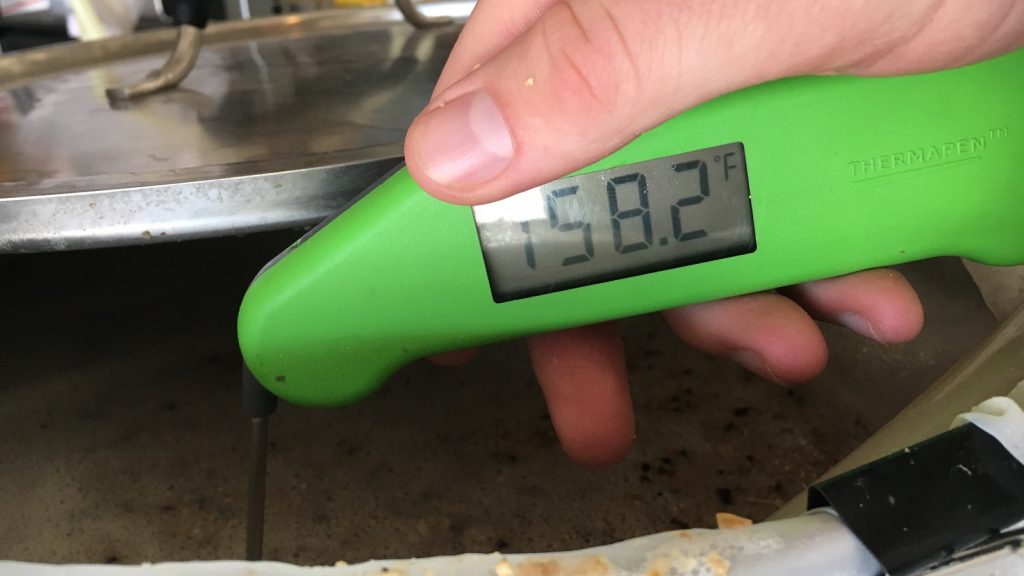
I recirculated the mash with the element off to allow the temperature to drop, though I wasn’t too concerned, as the beer would likely have a higher FG and thus lower ABV without being perceptibly sweeter. About 15 minutes into the mash, I took a pH reading that showed I was right on target.
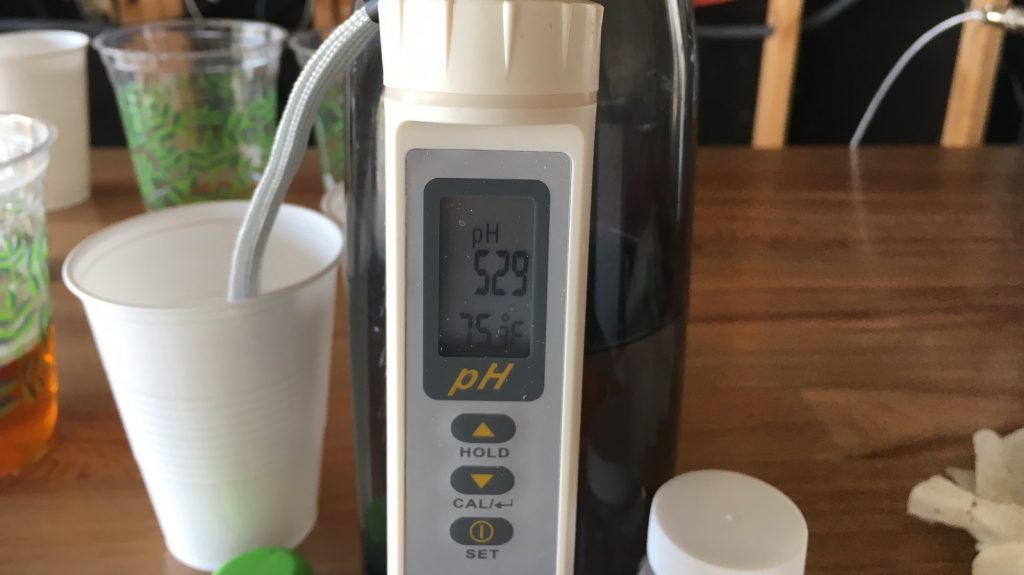
At the end of the 60 minute mash, I hoisted the bag of spent grains out of my kettle and let it drip sweet wort while the wort was heating up.
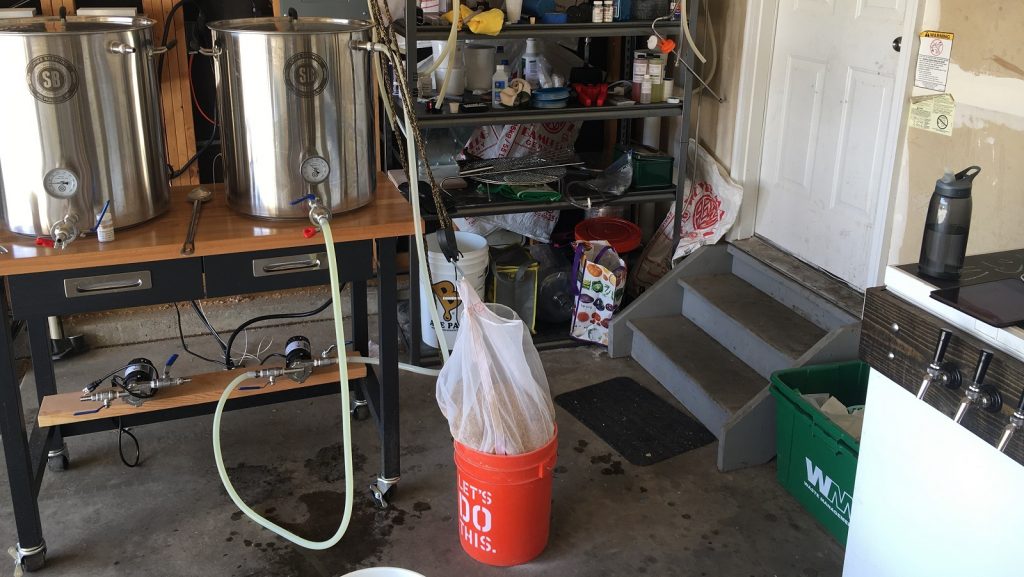
The wort was boiled for 60 minutes with hops added as noted in the recipe.
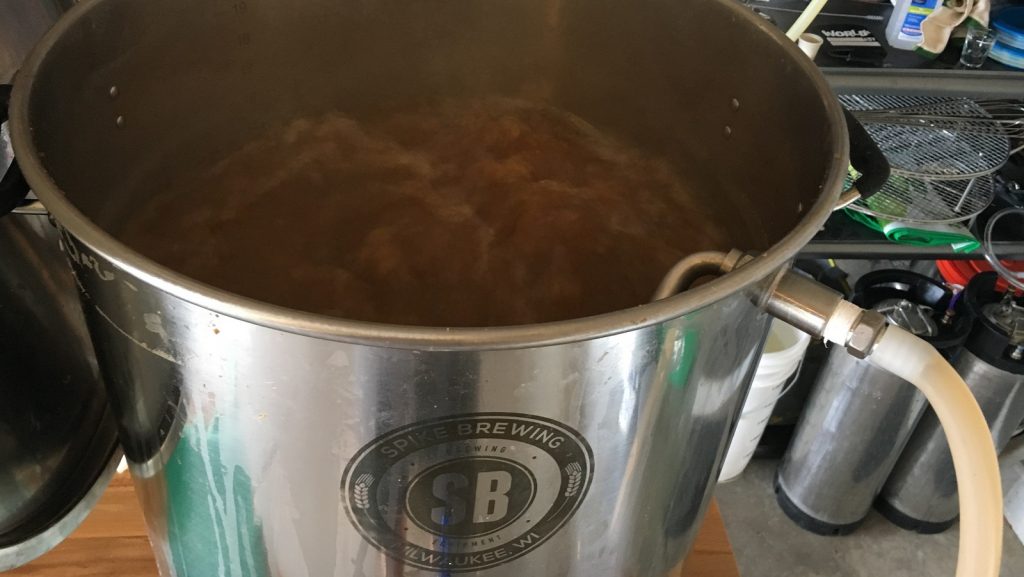
When the boil was finished, I quickly chilled the wort to slightly warmer than my groundwater temperature.
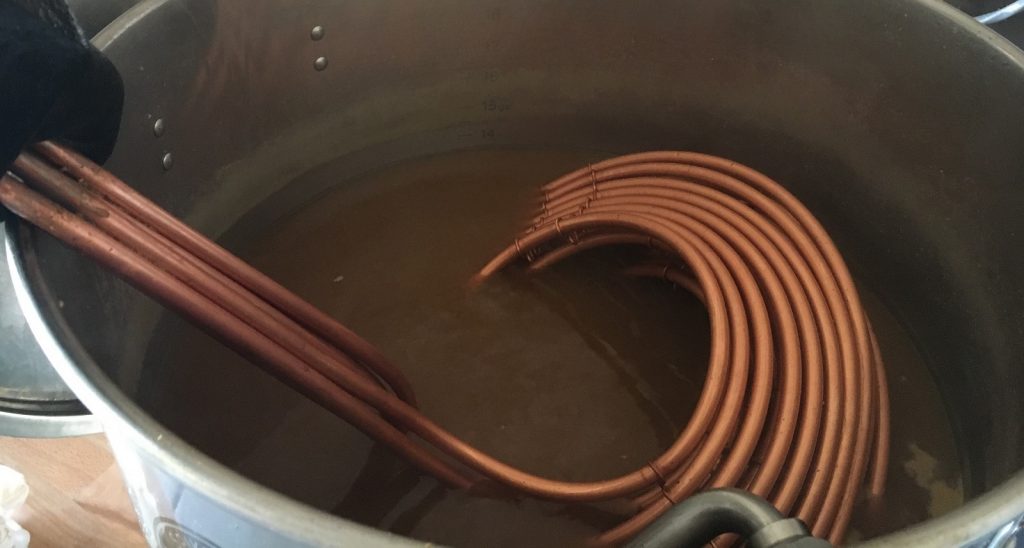
I took a hyrdometer measurement at this point to confirm the wort hit my target OG.
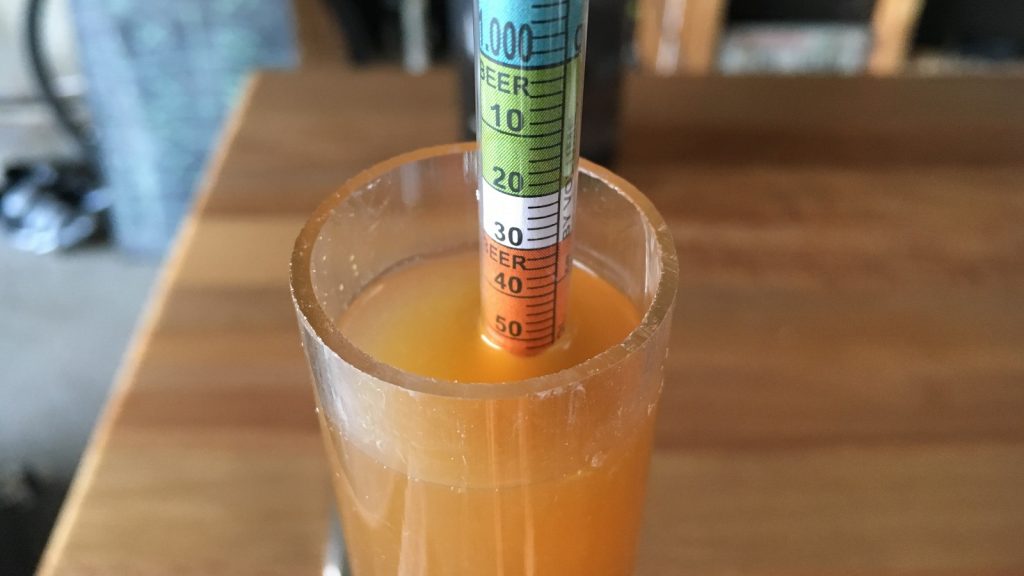
The wort was split evenly between two carboys that were subsequently placed in separate fermentation chambers, one controlled to 50°F/10°C and the other set at 66°F/19°C. They were left alone until the cool ferment wort dropped to the target temperature, at which point I pitched 2/3 of the starter into it and 1/3 into the warm ferment batch. I checked on the beers 24 hours later and observed the cool ferment batch had barely developed a kräusen while the warm ferment beer was ripping away.
Checking in 24 hours later, I noticed the cool ferment beer playing catch-up while the warm ferment beer appeared as though fermentation might be complete. Hydrometer measurements confirmed this was likely true, as the warm ferment batch was sitting at the predicted FG based on the warmer than expected mash temperature.
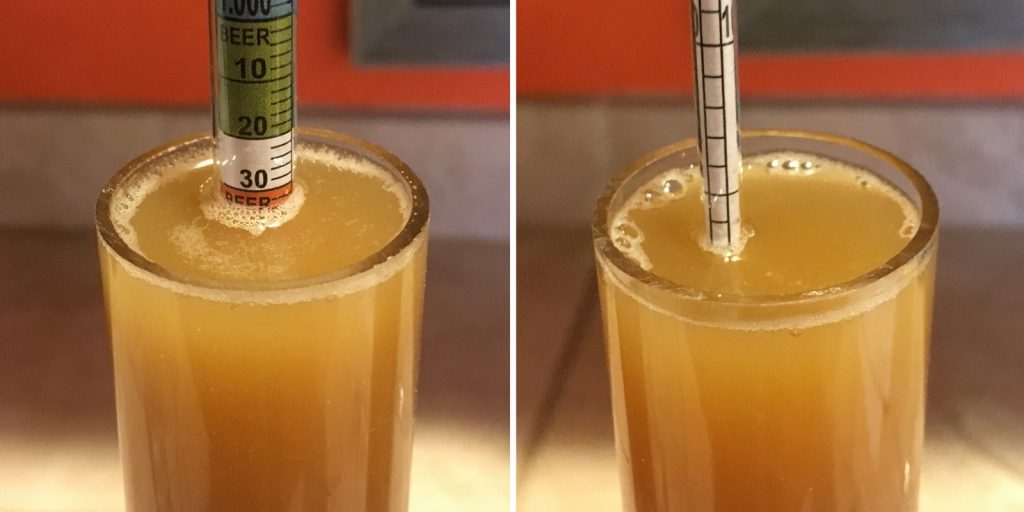
In order to ensure any differences caused by the variable would be present, I went against my typical process of ramping the temperature up for the cold ferment beer and instead opted to leave it at 50°F/10°C until it reached FG. At 9 days post-pitch, I took another set of hydrometer measurements showing the cool ferment batch was at FG and the warm ferment beer hadn’t changed.
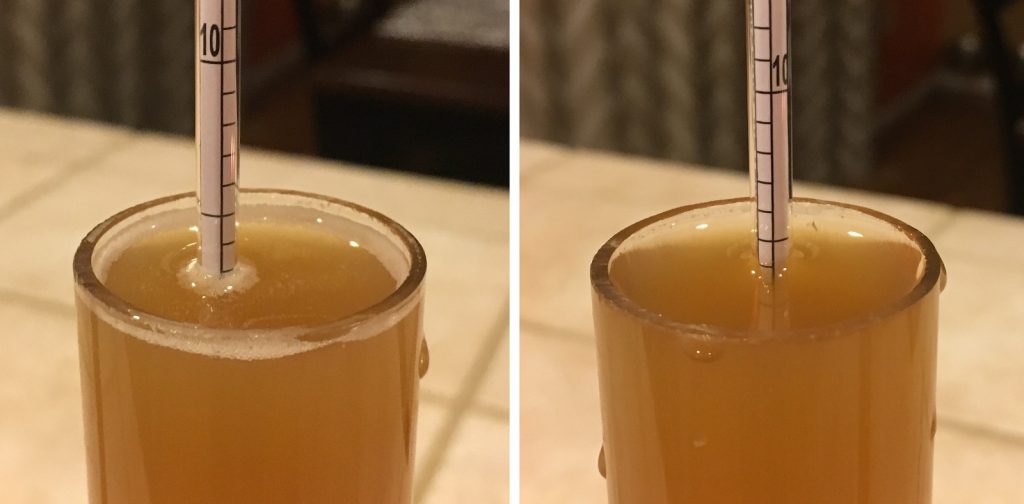
I moved the cool ferment beer next to the warm ferment beer in the 66°F/19°C chamber for a diacetyl rest.
I took a final hydrometer measurement 3 days later that showed no change in either batch, so I cold crashed both overnight, fined with gelatin, and kegged them up.
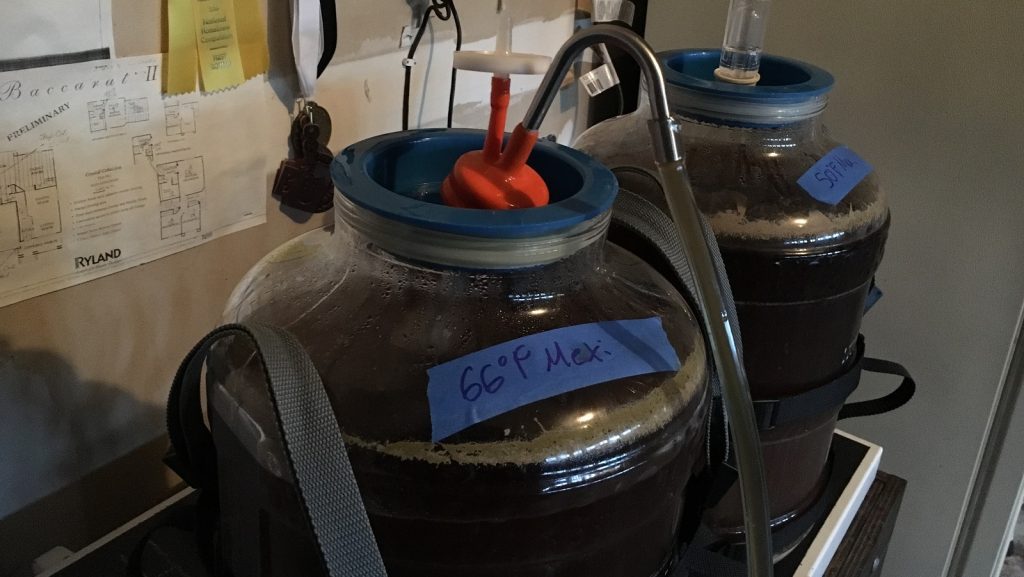
The filled kegs were placed in my keezer where they were briefly burst carbonated before I reduced the gas to serving pressure. After some conditioning time in my cold keezer, the beers were carbonated and ready to serve to unsuspecting tasters!
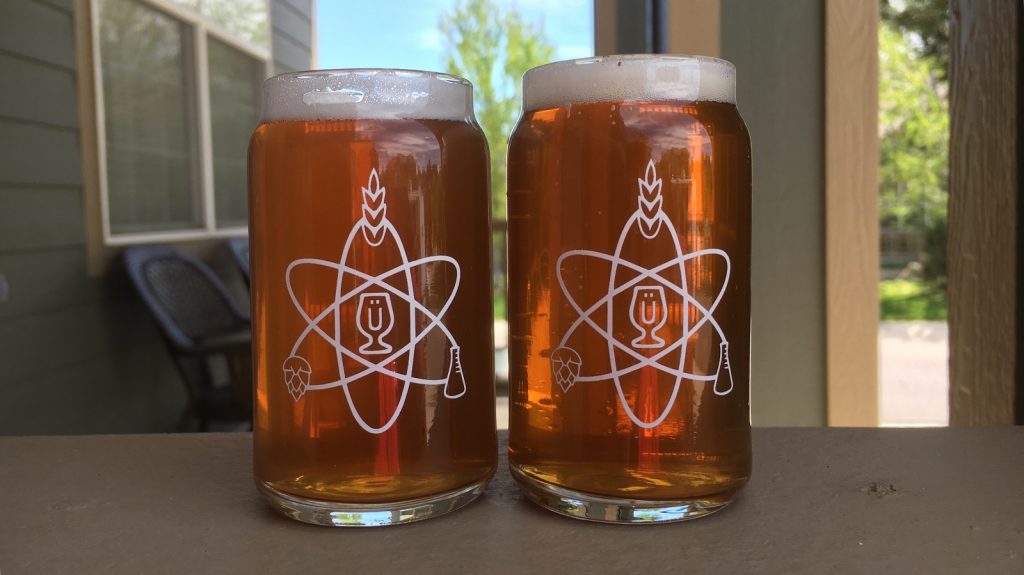
| RESULTS |
A total of 27 people of varying levels of experience participated in this xBmt. Each participant was served 2 samples of the cool ferment beer and 1 sample of the warm ferment beer then asked to identify the sample that was unique. A total of 14 tasters (p<0.05) would have had to select the unique sample to reach statistical significance, which is precisely how many identified the odd-beer-out (p=0.036), suggesting participants were able to reliably distinguish a Vienna Lager fermented with WLP940 yeast at 50°F/10°C from the same beer fermented at 66°F/19°C.
The participants who correctly selected the unique sample in the triangle test were instructed to complete a brief set of additional questions comparing only the two different beers, still blind to the nature of the xBmt. Of the 14 correct tasters, a staggeringly disproportionate 11 chose the cool ferment beer as their most preferred and while not a single person endorsed the warm ferment beer as being better. Two tasters said they noticed a difference but had no preference and only a single taster reported perceiving no difference between the beers.
My Impressions: Over the course of multiple semi-blind triangle tests, I was able to consistently distinguish the warm ferment beer from the cool ferment beer, though it required quite a bit of focus. In fact, trying to describe what it was that made these beers different to my palate is difficult, they just had a slightly different flavor. Both were very good, though with little hesitation, I’d have to say I preferred the one fermented cool. To me, it was slightly more crisp and smooth, while the warm ferment beer had a subtlest hint of something I can only describe as “sharp.”
| DISCUSSION |
Yeasts are living organisms, each strain possessing a unique genetic make-up, and hence it makes sense they’d respond differently to certain environmental pressures. Whereas strains like WLP800 Pilsner Lager yeast and Saflager W-34/70 seem to be less sensitive to temperature, the significant results of this xBmt suggest WLP940 Mexican Lager yeast may not be so robust. What’s even more bewildering to me is the fact all but 3 of the tasters who correctly identified the unique sample in the triangle test selected the cool ferment beer as their most preferred, while not even one liked the warm ferment beer more. The xBmt survey limits our ability to identify what exactly it was that influenced the tasters’ preference for the cool ferment beer, and while my personal preference aligned with theirs, it’s impossible to say if my reasons match the participants’.
Viewing the sensory and preference data together admittedly leaves me with an odd feeling of ambivalence. On one hand, there’s something about this confirmation of the conventionally accepted approach that feels kind of good, a reminder that methods developed eons ago still matter today. However, as someone who appreciates the less time intensive process of fermenting lagers at ale temperatures, I wouldn’t have been bummed out if the beers were indistinguishable. Ultimately, I appreciate these results and will keep them in mind them when using WLP940 in the future, though given how similar I experienced the beers to be, I’ll ferment warm with this yeast again.
One final thing I want to address– claims that a difference in fermentation temperature as small as a couple degrees will produce a noticeable difference. Considering the fact barely half of the participants in this xBmt chose the correct beer in the triangle test when they were fermented 16°F/9°C apart, along with the numerous other non-significant lager fermentation temperature xBmts, it seems worrying over a fermenting beer hitting 50°F/10°C when one planned on 48°F/9°C is likely for naught.
If you have thoughts about this xBmt, please share them in the comments section below!
Support Brülosophy In Style!
All designs are available in various colors and sizes on Amazon!
Follow Brülosophy on:
FACEBOOK | TWITTER | INSTAGRAM
If you enjoy this stuff and feel compelled to support Brulosophy.com, please check out the Support Us page for details on how you can very easily do so. Thanks!


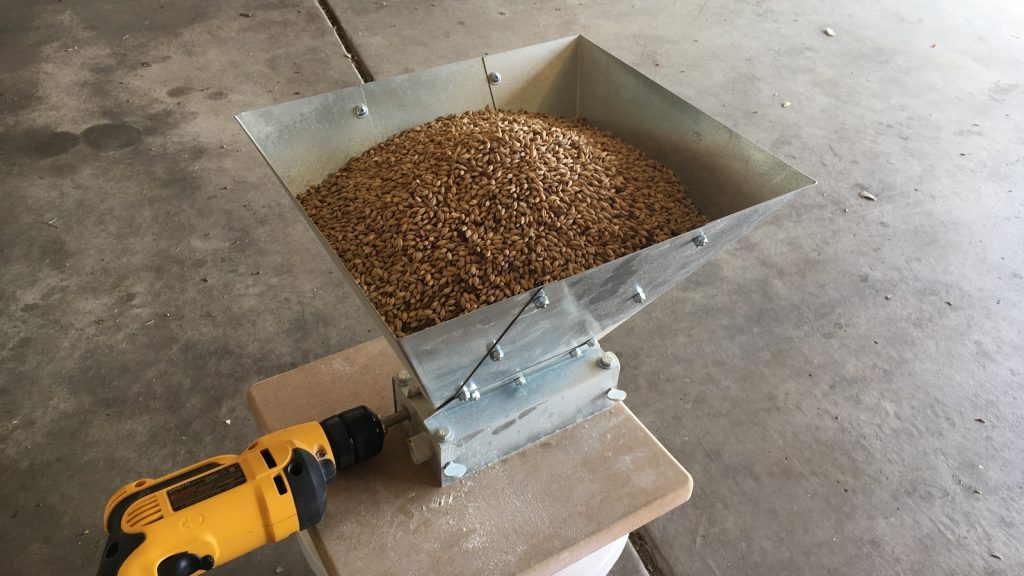
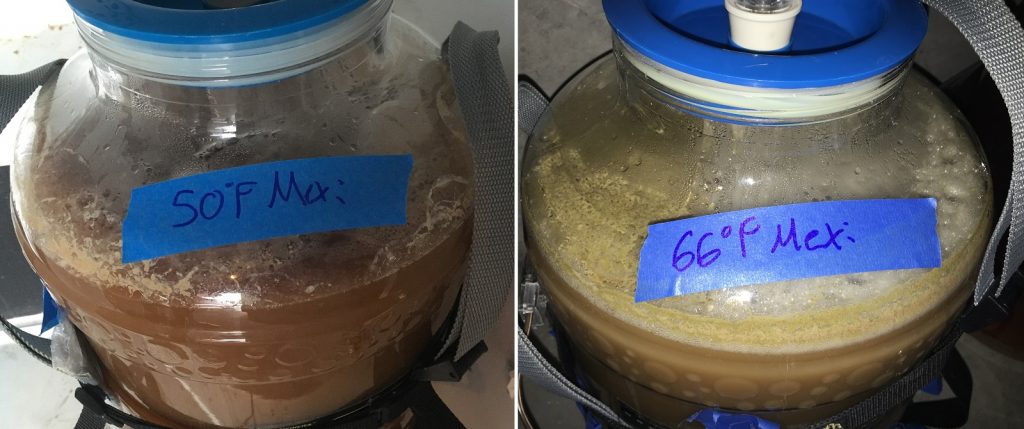
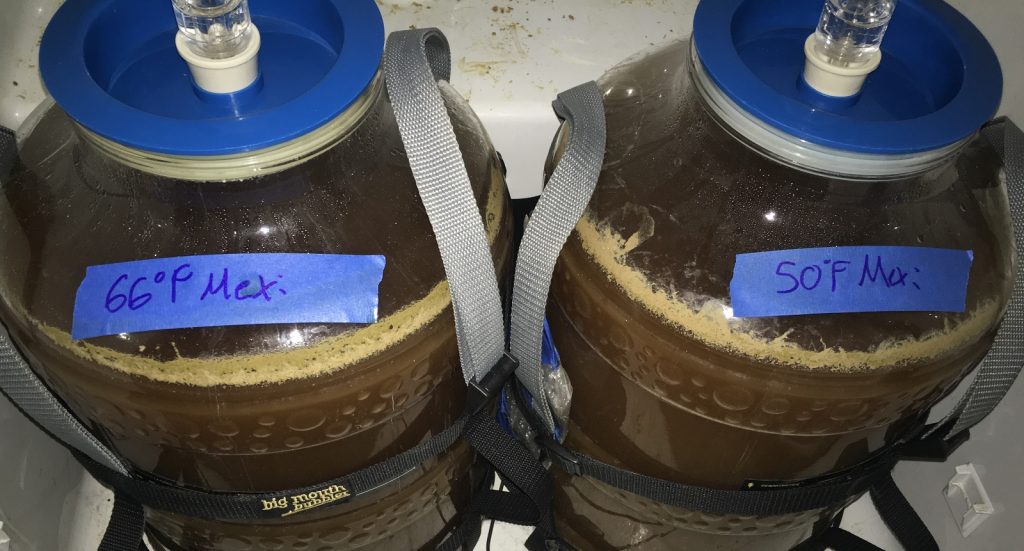










19 thoughts on “exBEERiment | Fermentation Temperature: WLP940 Mexican Lager Yeast In A Vienna Lager”
Cool exbeeriment! What pitching rate do you use when you ferment lagers at warmer temperatures? Given the significance, would you just cut the temperature next time to 58 or 60 and call it good?
Hi guys. 14 distinguished the cool one. 9 preffered the cool, 2 did not have any preferrency, and 1 did not perceived any difference. What happen with the other 2 persons?
I’m curious why you decided to add a potentially confounding variable and not pitch them equally. Your result could be explained by the warm batch being relatively under pitched, or a combination of under pitching and higher temperature.
What “underpitch”. He used to determine the correct amount of yeast for each pitch.
Completely agree. If two variables are introduced the experiment is not only fermentation temperature, it is a complex of variables for two different beers.
Agreed. Any conclusion has little meaning
Pitching the same amount would be what introduces the variable, unintuitively. If you’re pitching the exact same amount of yeast you’d be underpitching for the cooler temperature and then your experiment becomes “Can people tell the difference between a properly-pitched batch fermented warm and a way underpitched batch fermented cold,” instead of “Can people tell the difference between two properly-pitched batches fermented at different temperatures.”
Food for thought, I made it to White Labs tasting room this year and got to try their flight of lagers. 940 was the best one to me because it has this very subtle interesting spiciness in the background, where none of the other lager yeasts do. Perhaps the underpitch and higher temps made that stand out in a not so pleasant way?
Do these results say more about pitch rate or fermentation temperature? Doubling down on the pitch rate for the warmer fermented beer might change the results, no?
I honestly don’t know which it speaks more to. All we know is it was sig in this instance with both and in the past it’s been insig when isolated
I have to agree with the other comments about your pitch rates. What was the determining factor for this oddity? While you say the difference in pitch rates was insignificant in the past, you introduced a variable that should not have been. To be wholly accurate, all variables, with the exception of the one you were testing for, should have been equal, whether or not you believed them to significant. I would say could have been a cool (no pun intended) and potentially mind changing exbeeriment, but ya kinda blew it with the odd pitch rate.
I don’t really understand these types of comments. There’s not much constructive here. It’s not like there’s no precedence for adding more yeast to a cool-fermented lager, any pitching rate calculator will tell you to do that.
Not only that, experiments like these are exactly what the Brulosophy guys say – a single point of data. This is part 10 in the lager temperature series. Why wouldn’t you take this as a single point of data for what it is? In my opinion you could at least
a) suggest to retry the experiment with the same amount of yeast pitched into both the warm and cool fermented beers, or better
b) try it out yourself the way YOU think it should be done, get at least 27 people to triangle test, and post a response with you results.
Awesome timing for this exbeeriment. I currently have a Mexican Lager going (using WLP940) that I also wanted to see how the warm ferment pans out. Although I just couldn’t convince myself to ferment that warm, I went with 15C. It ripped through the sugars in just a few days. D-rest complete I’ll cold crash tonight. Good to know it will probably turn out fine,
Cool experiment – thanks. Curious, do you oxygenate / Aerate your wort after you chill it? before pitching the yeast? Thanks, Brian.
WLP940 is my house yeast that I have used a solid 80 times or so. It will throw esters over 60F ish even with high pitching rates, adequate oxygen etc. I’m glad you did this yeast; it’s awesome. This just reiterates that every yeast is different, and the lab’s fermentation temperature range is just a safe guideline that you will have to push to see how accurate. It’s also good to know that some lager strains don’t need to be fermented cold to get those flavors.
Adding a little to the above comments, there is an assumption that hot and cold fermentation temps are the reason for higher and lower pitching rates but we double the pitching rate for a DIFFERENT SPECIES of yeast, fermenting at colder temperatures. When we know that underpitching causes stress in yeast, who’s to say that they haven’t underpitched at the hotter temperatures in this experiment?
I don’t think it’s unhelpful to mention this, perhaps there are more courteous ways to bring this up but I’m in with the underpitching side here. I’d like to know whether standard lager pitching rates at room temp don’t cause yeast stress and the flavours associated at warmer temps.
I am testing out the 940 under pressure for the moment at 1bar first 3 days at 17 celcius and then 19 celcius.
Opposite to w34/70 which ferment fast in that condition it has rather showed a normal fermentation curve.
Have not finished the test but this is perhaps an idea for you guys to try out.
I’m about to do a Mexican lager with 940. What have your results been? I usually ferment warmer and under pressure and get great lagers, but haven’t tried 940.
Our xBmt results would suggest that the Grupo Modelo strain (940) may produce different characteristics based on ferm temp, but people anecdotally seem to think warmer temps result a more lager-like character. Moreover, our xBmts have yet to support the notion that fermenting under pressure has any impact at all, regardless of strain or temp.